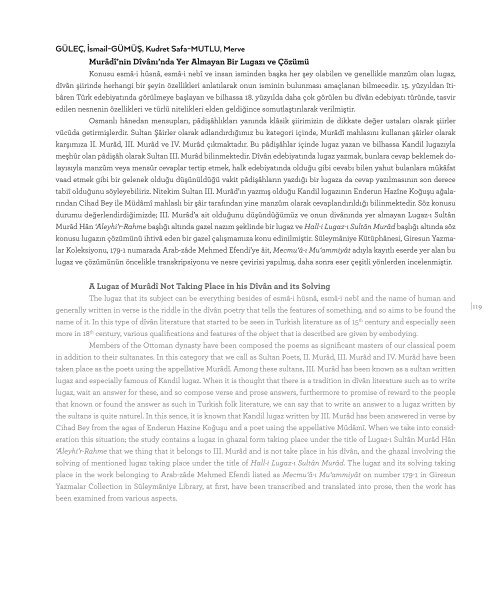14 - 17
MdZ0re
MdZ0re
You also want an ePaper? Increase the reach of your titles
YUMPU automatically turns print PDFs into web optimized ePapers that Google loves.
GÜLEÇ, İsmail-GÜMÜŞ, Kudret Safa-MUTLU, Merve<br />
Murâdî’nin Dîvânı’nda Yer Almayan Bir Lugazı ve Çözümü<br />
Konusu esmâ-i hüsnâ, esmâ-i nebî ve insan isminden başka her şey olabilen ve genellikle manzûm olan lugaz,<br />
dîvân şiirinde herhangi bir şeyin özellikleri anlatılarak onun isminin bulunması amaçlanan bilmecedir. 15. yüzyıldan îtibâren<br />
Türk edebiyatında görülmeye başlayan ve bilhassa 18. yüzyılda daha çok görülen bu dîvân edebiyatı türünde, tasvir<br />
edilen nesnenin özellikleri ve türlü nitelikleri elden geldiğince somutlaştırılarak verilmiştir.<br />
Osmanlı hânedan mensupları, pâdişâhlıkları yanında klâsik şiirimizin de dikkate değer ustaları olarak şiirler<br />
vücûda getirmişlerdir. Sultan Şâirler olarak adlandırdığımız bu kategori içinde, Murâdî mahlasını kullanan şâirler olarak<br />
karşımıza II. Murâd, III. Murâd ve IV. Murâd çıkmaktadır. Bu pâdişâhlar içinde lugaz yazan ve bilhassa Kandil lugazıyla<br />
meşhûr olan pâdişâh olarak Sultan III. Murâd bilinmektedir. Dîvân edebiyatında lugaz yazmak, bunlara cevap beklemek dolayısıyla<br />
manzûm veya mensûr cevaplar tertip etmek, halk edebiyatında olduğu gibi cevabı bilen yahut bulanlara mükâfat<br />
vaad etmek gibi bir gelenek olduğu düşünüldüğü vakit pâdişâhların yazdığı bir lugaza da cevap yazılmasının son derece<br />
tabiî olduğunu söyleyebiliriz. Nitekim Sultan III. Murâd’ın yazmış olduğu Kandil lugazının Enderun Hazîne Koğuşu ağalarından<br />
Cihad Bey ile Müdâmî mahlaslı bir şâir tarafından yine manzûm olarak cevaplandırıldığı bilinmektedir. Söz konusu<br />
durumu değerlendirdiğimizde; III. Murâd’a ait olduğunu düşündüğümüz ve onun divânında yer almayan Lugaz-ı Sultân<br />
Murâd Hân ‘Aleyhi’r-Rahme başlığı altında gazel nazım şeklinde bir lugaz ve Hall-i Lugaz-ı Sultân Murâd başlığı altında söz<br />
konusu lugazın çözümünü ihtivâ eden bir gazel çalışmamıza konu edinilmiştir. Süleymâniye Kütüphânesi, Giresun Yazmalar<br />
Koleksiyonu, <strong>17</strong>9-1 numarada Arab-zâde Mehmed Efendi’ye âit, Mecmu‘â-ı Mu‘ammiyât adıyla kayıtlı eserde yer alan bu<br />
lugaz ve çözümünün öncelikle transkripsiyonu ve nesre çevirisi yapılmış, daha sonra eser çeşitli yönlerden incelenmiştir.<br />
A Lugaz of Murâdî Not Taking Place in his Dîvân and its Solving<br />
The lugaz that its subject can be everything besides of esmâ-i hüsnâ, esmâ-i nebî and the name of human and<br />
generally written in verse is the riddle in the dîvân poetry that tells the features of something, and so aims to be found the<br />
name of it. In this type of dîvân literature that started to be seen in Turkish literature as of 15 th century and especially seen<br />
more in 18 th century, various qualifications and features of the object that is described are given by embodying.<br />
Members of the Ottoman dynasty have been composed the poems as significant masters of our classical poem<br />
in addition to their sultanates. In this category that we call as Sultan Poets, II. Murâd, III. Murâd and IV. Murâd have been<br />
taken place as the poets using the appellative Murâdî. Among these sultans, III. Murâd has been known as a sultan written<br />
lugaz and especially famous of Kandil lugaz. When it is thought that there is a tradition in dîvân literature such as to write<br />
lugaz, wait an answer for these, and so compose verse and prose answers, furthermore to promise of reward to the people<br />
that known or found the answer as such in Turkish folk literature, we can say that to write an answer to a lugaz written by<br />
the sultans is quite naturel. In this sence, it is known that Kandil lugaz written by III. Murâd has been answered in verse by<br />
Cihad Bey from the agas of Enderun Hazine Koğuşu and a poet using the appellative Müdâmî. When we take into consideration<br />
this situation; the study contains a lugaz in ghazal form taking place under the title of Lugaz-ı Sultân Murâd Hân<br />
‘Aleyhi’r-Rahme that we thing that it belongs to III. Murâd and is not take place in his dîvân, and the ghazal involving the<br />
solving of mentioned lugaz taking place under the title of Hall-i Lugaz-ı Sultân Murâd. The lugaz and its solving taking<br />
place in the work belonging to Arab-zâde Mehmed Efendi listed as Mecmu‘â-ı Mu‘ammiyât on number <strong>17</strong>9-1 in Giresun<br />
Yazmalar Collection in Süleymâniye Library, at first, have been transcribed and translated into prose, then the work has<br />
been examined from various aspects.<br />
|119


